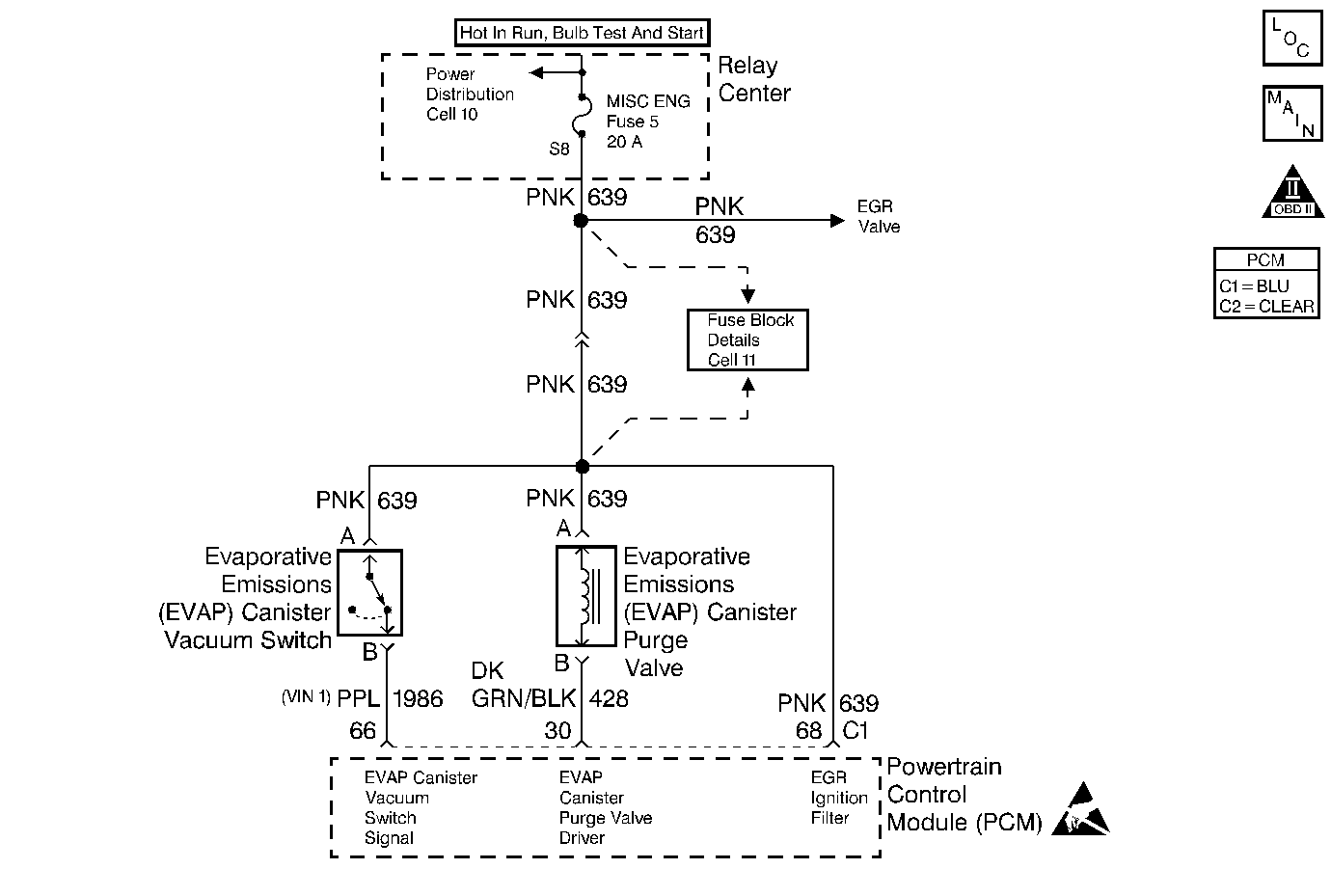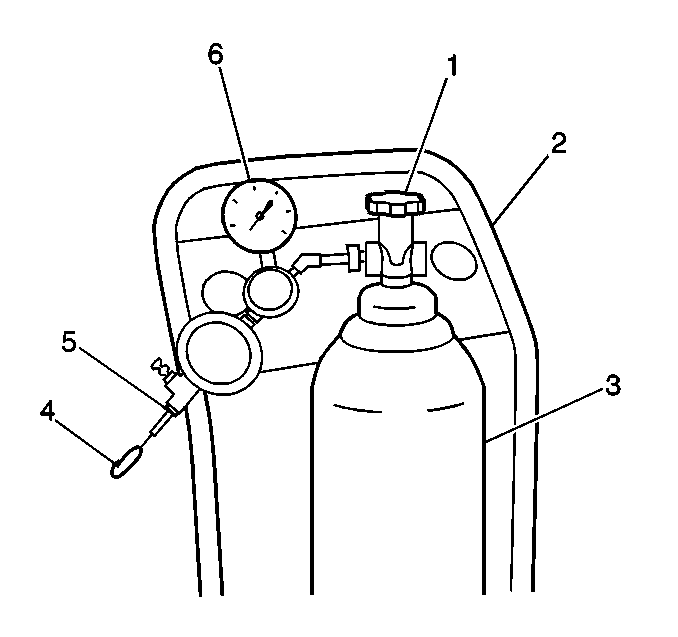
Circuit Description
The EVAP vacuum switch is a normally closed switch positioned in the purge line between the canister and the EVAP purge valve. The EVAP purge vacuum switch will open when vacuum increases to greater than 5 inches of water in the purge line. The PCM monitors the EVAP vacuum switch signal to determine if the evaporative emission control system is working properly. If the EVAP vacuum switch signal circuit is open when vacuum sufficient to open the EVAP vacuum switch should not be present, DTC P1442 will set.
Conditions for Setting the DTC
The EVAP purge vacuum switch circuit is open during key ON (before the engine is cranked).
Action Taken When the DTC Sets
| • | The PCM will illuminate the malfunction indicator lamp (MIL) during the second consecutive trip in which the diagnostic test has been run and failed. |
| • | The PCM will store conditions which were present when the DTC set as Freeze Frame and Failure Records data. |
Conditions for Clearing the MIL/DTC
| • | The PCM will turn OFF the MIL during the third consecutive trip in which the diagnostic has been run and passed. |
| • | The History DTC will clear after 40 consecutive warm-up cycles have occurred without a malfunction. |
| • | The DTC can be cleared by using the scan tool. |
Diagnostic Aids
Check for the following conditions:
| • | Poor connection at the PCM. |
| Inspect harness connectors for backed out terminals, improper mating, broken locks, improperly formed or damaged terminals, and poor terminal to wire connection. |
| • | Damaged harness. |
| Inspect the wiring harness for damage. If the harness appears to be OK, observe the EVAP vacuum switch display on the scan tool while moving connectors and wiring harnesses related to the sensor. A change in the display will indicate the location of the malfunction. |
| • | Restricted fuel vapor line, purge hose, canister vent, or blocked canister. |
| A condition that causes the EVAP system to trap vacuum can keep the EVAP vacuum switch open, causing DTC P1442 to be set. |
| • | Malfunctioning or damaged canister. |
| A malfunctioning canister may intermittenly allow charcoal into the EVAP purge solenoid, vacuum switch, and associated lines causing a DTC to be set. Use the following procedure to check for a carbon release condition: |
| 1. | Turn OFF the ignition switch. |
| 2. | Remove the EVAP purge solenoid. Refer to Evaporative Emission Canister Purge Solenoid |
| 3. | Remove the EVAP vacuum switch. Refer to Evaporative Emission Vacuum Switch |
| 4. | Lightly tap the purge solenoid and (if applicable) the vacuum switch on a clean work area looking for carbon particles exiting either of the vacuum ports. |
| 5. | If no carbon release is evident, reinstall the components and continue with the DTC P1442 diagnostic table. If carbon is being released from either component, continue with this service procedure. |
| 6. | Remove the charcoal canister from the vehicle. |
| 7. | Ensure that the main cylinder valve is turned off on the

|
| 8. | Disconnect the black hose that connects the nitrogen cylinder to the EVAP purge/pressure diagnostic station at the pressure regulator by unscrewing the knurled nut on the regulator. No tools are required to remove the black hose from the regulator. |
| 9. | Using a section of vacuum line, connect one end over the open threaded fitting of the EVAP purge/pressure diagnostic station pressure regulator. |
| 10. | Connect the remaining end to the purge solenoid end of the EVAP purge line at the vehicle and turn on the main nitrogen cylinder valve. Continue to blow any debris from the purge line for 15 seconds. |
| 11. | Return the EVAP Pressure/Purge Diagnostic Station to its original condition by re-installing the black hose that was disconnected in step 8. |
| 12. | Replace the following components: |
| • | The EVAP purge solenoid. Refer to Evaporative Emission Canister Purge Solenoid . |
| • | The EVAP canister. Refer to Evaporative Emission Canister Replacement . |
| • | The EVAP vacuum switch. Refer to Evaporative Emission Vacuum Switch . |
| 13. | Proceed with the DTC P1442 diagnostic table. |
Reviewing the Fail Records vehicle mileage since the diagnostic test last failed may help determine how often the condition that caused the DTC to be set occurs. This may assist in diagnosing the condition.
Test Description
Number(s) below refer to the step number(s) on the Diagnostic Table.
-
The EVAP vacuum switch is normally closed when no vacuum is present. With the key ON and the engine not running, there shouldn't be any vacuum present in the EVAP system.
-
Determines if the PCM is able to control the EVAP purge valve.
-
Determines if the DTC will set under the conditions present when the DTC was originally stored. If not, the malfunction is intermittent.
-
This vehicle is equipped with a PCM which utilizes an Electrically Erasable Programmable Read Only Memory (EEPROM). When the PCM is being replaced, the new PCM must be programmed.
Step | Action | Value(s) | Yes | No | ||||||
|---|---|---|---|---|---|---|---|---|---|---|
1 | Was the Powertrain On-Board Diagnostic (OBD) System Check performed? | -- | ||||||||
With the ignition ON, engine not running, observe EVAP Vacuum Sw. display on the scan tool. Does EVAP Vacuum Sw. display No Purge? | -- | |||||||||
Does the scan tool indicate DTC P1442 failed? | -- | Refer to Diagnostic Aids | ||||||||
Does EVAP Vacuum Sw. display No Purge? | -- | |||||||||
5 |
Was a problem found? | -- | ||||||||
6 |
Was a problem found? | -- | ||||||||
Replace the PCM. Important:: The replacement PCM must be programmed. Go to Powertrain Control Module Replacement/Programming . Is action complete? | -- | -- | ||||||||
8 |
Important: Check for carbon release into the EVAP system. Refer to Diagnostic Aids. Was a problem found? | -- | ||||||||
9 |
Was a problem found? | -- | ||||||||
10 | Replace the EVAP vacuum switch. Go to Evaporative Emission Vacuum Switch . Important: Check for carbon release into the EVAP system. Refer to Diagnostic Aids. Is action complete? | -- | -- | |||||||
11 |
Does EVAP Vacuum Sw. display No Purge? | -- | System OK |
